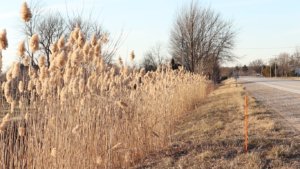Phragmites a growing concern in Windsor-Essex
As winter melts away, a new concern grows in Windsor-Essex: Phragmites Australis.
Also known as the common reed, Phragmites is an invasive species of plant that has been in the area for decades. Thriving in wetlands and ditches, Phragmites have been spreading throughout Windsor-Essex, growing up to three metres in height and killing other plants near its roots.
Essex Region Conservation Authority Director of Communications Danielle Steubing said she believed the plant was introduced innocently.
“If you don’t know how dangerous it is, it can appear to be quite pretty,” Steubing said. “There was a time where people were planting it as ornamental grasses but it’s gotten out of control.”
The roots of the plant, known as rhizomes, spread out lateral to the ground and release toxins that kill other plant life growing nearby. There have been cases where the densely growing weed has caused wildlife to die from starvation because they can’t escape the stalks after they have entered.
Progress is being made on removing the invasive species and preventing it from damaging wildlife further. Kingsville town council recently announced a collaboration with the University of Windsor to combat and study the effects of Phragmites.

Phragmites grow in wetlands and drainage systems throughout Windsor-Essex. (Photo by Tyler Stein)
Kingsville Drainage Superintendent & Weed Inspector Ken Vegh said he is hopeful that they can manage the invasive species and eventually eradicate it, but he recognizes that it will take time.
“We’re gaining on it,” Vegh said. “But then there’s other areas that it took an hour in 2014 to manage, and it takes us about an hour still.”
The effects of Phragmites do not only affect animals and plants, it also harms agriculture across the county. The roots are so dense that it impedes the surface water on fields from properly draining into the ditches and other drainage systems.
“The sediment within the water drops out,” Vegh said. “[That causes] soil build up in the drain and slower surface water runoff.”
Different methods can be used to remove or kill Phragmites from the areas they infest. Using herbicides, a focused and time-intensive application to each individual stalk can kill it without harming other plants nearby. Another way is spraying the plant once it gets taller and reaches a height where it can solely be hit with the herbicide, and will lay down as it dies. The most common method is removing the roots with tools or by hand without herbicide, though it takes significantly more time.
ERCA believes that the currently elevated water levels carry no threat to encouraging growth of Phragmites, and if anything, may help drown out areas that the plants reside in.
The best way for residents of Windsor-Essex to combat the invasive species is to remove the roots or mow stalks to impede growth.


